Courland
Courland (/ˈkʊərlənd/; Latvian: Kurzeme; Livonian: Kurāmō; German and Scandinavian languages: Kurland; Latin: Curonia/Couronia; Russian: Курляндия; Lithuanian: Kuršas; Polish: Kurlandia), is one of the historical and cultural regions in western Latvia. The largest city is Liepāja, the third largest city in Latvia. The regions of Semigallia and Selonia are sometimes considered as part of Courland as they were formerly held by the same duke.
Courland Kurzeme | |
|---|---|
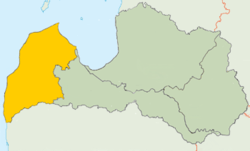 | |
| Country | Latvia |
| Capital | Kuldīga |
Geography and climate
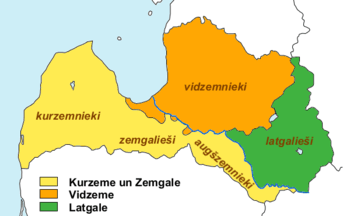
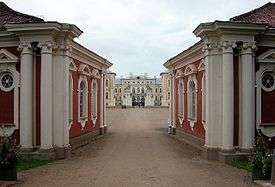
Situated in western Latvia, Courland roughly corresponds to the former Latvian districts of Kuldīga, Liepāja, Saldus, Talsi, Tukums and Ventspils.
When combined with Semigallia and Selonia, Courland's northeastern boundary is the river Daugava, which separates it from the regions of Latgale and Vidzeme. To the north, Courland's coast lies along the Gulf of Riga. On the west it is bordered by the Baltic Sea, and on the south by Lithuania. It lies between 55° 45′ and 57° 45′ North and 21° and 27° East.
The area comprises 27,286 km² (10,535 sq.mi.), of which 262 km² (101 sq.mi.) is made up of lakes. The landscape generally has a low and undulating character, with flat and marshy coastlands. The interior features wooded dunes, covered with pine, spruce, birch, and oak, with swamps and lakes, and fertile patches between. Courland's elevation never rises more than 213 m (700 ft) above sea level.
The Jelgava plain divides Courland into two parts, the western side, which is fertile and densely inhabited, except in the north, and the eastern side, less fertile and thinly inhabited.
Nearly one hundred rivers drain Courland, but only three of these rivers – the Daugava, the Lielupe and the Venta – are navigable. They all flow northwestward and discharge into the Baltic Sea.
Owing to its numerous lakes and marshes, Courland has a damp, often foggy, and changeable climate; its winters are severe.
History
Early history
In ancient times the Curonians, a pagan tribe, inhabited Courland. The Brethren of the Sword, a German military order, subdued the Curonians and converted them to Christianity in the first quarter of the 13th century. Thus in 1230 the Curonian king Lammekinus (Lamikis) made peace directly with the papal legate. He accepted baptism, and became a vassal of the pope.[1] In 1237 the area passed into the rule of the Teutonic Knights owing to the amalgamation of this order with that of the Brethren of the Sword.
Livonian Confederation
The Livonian Confederation was a loosely organized confederation formed by the German-led Livonian Order and various bishoprics that encompassed much of present-day Estonia and Latvia. It existed from 1228 to the 1560s, when it was dismembered during the Livonian Wars.
Duchy of Courland and the Polish–Lithuanian Commonwealth, 1561–1795
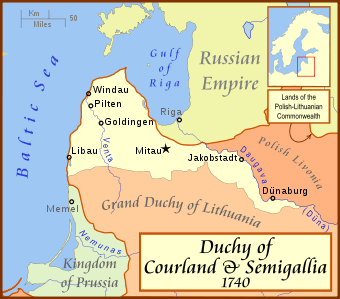
The Duchy of Courland and Semigallia was a semi-independent duchy that existed from 1561 until 1795, encompassing the areas of Courland and Semigallia. Although nominally a vassal state of the Polish–Lithuanian Commonwealth, the dukes operated autonomously. In the 18th century Russia acquired great influence over the Duchy; the future Empress Anna of Russia served as regent there from 1711 until her accession the Russian throne in 1730. After the last of the ducal line into which she had married died in 1737, she arranged for the Duchy to be given to her lover, Ernst Johann von Biron instead.
The Duchy was one of the smallest European nations to colonize overseas territories, establishing short-lived outposts on the Caribbean islands of Tobago and Trinidad and at the mouth of the Gambia River in Africa on what was then known as James Island.
In 1795, the last Duke, Peter von Biron, ceded the Duchy to the Russian Empire.
The former Bishopric of Courland was directly incorporated into the Polish–Lithuanian Commonwealth as the District of Pilten of the Wenden and later Inflanty Voivodeship.
Courland as part of Russian Empire
After annexation by the Russian Empire, the territory of the former Duchy formed the Courland Governorate.
From the time of the Northern Crusades in the early 13th century, most land was owned by nobles descended from the German invaders. In 1863, the Russian authorities issued laws to enable Latvians, who formed the bulk of the population, to acquire the farms which they held, and special banks were founded to help them. By this means, some occupants bought their farms, but the great mass of the population remained landless, and lived as hired labourers, occupying a low position in the social scale.
Agriculture was the chief occupation, with the principal crops being rye, barley, oats, wheat, flax, and potatoes. The large estates conducted agriculture with skill and scientific knowledge. Fruit grew well. Excellent breeds of cattle, sheep and pigs were kept. Liepāja and Jelgava operated as the principal industrial centres, with ironworks, agricultural machinery works, tanneries, glass and soap works. Flax spinning took place mostly as a domestic industry. Iron and limestone were the chief minerals; a little amber was found on the coast. The only seaports were Liepāja, Ventspils and Palanga, there being none on the Courland coast of the Gulf of Riga.
Population
In 1870 the population was 619,154; in 1897 it was 674,437 (of whom 345,756 were women); in 1906 it was estimated at 714,200. Of the whole, 79% were Latvians, 8.4% Baltic Germans, about 8% Jews,[3] 1.4% Russians, 1% Lithuanians, 1% Poles, and some Livonians.
The chief towns of the ten districts were Jelgava (Mitau), Courland's capital (pop. 35,011 in 1897); Liepāja (Libau) (pop. 64,500 in 1897); Bauska (6,543); Jaunjelgava (Friedrichstadt) (5,223); Kuldīga (Goldingen) (9,733); Grobiņa (1,489); Aizpute (Hasenpoth) (3,338); Ilūkste (Illuxt) (2,340); Talsi (Talsen) (6,215); Tukums (Tuckum) (7542); and Ventspils (Windau) (7,132).
75% of the population belonged to the prevailing denomination, Lutheranism; the rest belonged to the Eastern Orthodox and Roman Catholic churches. There was a small but vigorous Jewish population.
Courland during and after World War I
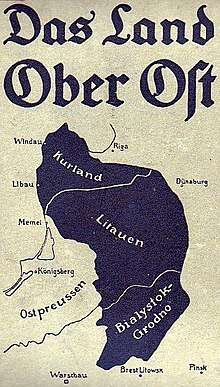
During World War I, Courland formed part of the Eastern Front theatre of operations that saw fighting primarily between forces of the Russian and German Empires. Following Russia's Great Retreat of 1915, Courland came under control of the German Army's Ober Ost commander in the person of Paul von Hindenburg, a Prussian military hero. (The Russian authorities of the Courland Governorate were exiled to Tartu never to return.) With large territories coming under the Ober Ost's administration as a result of military successes on the Eastern Front, General Erich Ludendorff was charged with managing the large area now under its jurisdiction. Courland District (which included parts of Semigallia) was made one of three districts of the region, which also came to be known as Ober Ost.
As Russian rule in the rest of what is now Latvia began collapsing at the end of World War I, Baltic Germans began a process of forming provincial councils between September 1917 and March 1918, competing with ethnic Latvians' moves toward independence. With the Treaty of Brest-Litovsk of 3 March 1918, Russia's new Bolshevik government formally relinquished control of Courland to Germany. The Duchy of Courland and Semigallia was proclaimed on 8 March 1918 by a Baltic German Landesrat, who offered the crown of the duchy to German Kaiser Wilhelm II. Wilhelm recognised the duchy as a German vassal that same month. However, the duchy was absorbed on 22 September 1918 by the United Baltic Duchy. On 18 November 1918, Latvia proclaimed its independence and on 7 December 1918, the German military handed over authority to the pro-German Latvian Provisional Government headed by Kārlis Ulmanis. By January 1919, much of Courland had been overrun by the Bolsheviks' Latvian Socialist Soviet Republic but the provisional government with the aid of German forces pushed back and took back Courland by April. Throughout the Latvian War of Independence, much of Courland remained a German stronghold. Latvia eventually signed a cease-fire with Germany on 15 July 1920, and the Treaty of Riga of 11 August ended the war.
Courland as part of interbellum Latvia
After World War I, Courland became one of five provinces of the newly formed nation of Latvia. These provinces corresponded to Latvia's four traditional regions plus Riga. In 1935, Courland had an area of 13,210 square kilometres (5,099 sq mi) and a population of 292,659 making it the least populous of the provinces.[4]
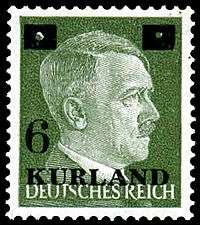
Courland during and after World War II
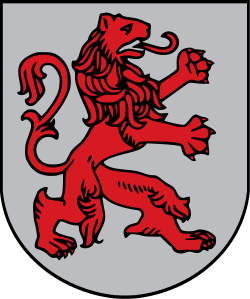 Historical affiliations of Courland | |||
| Curonian lands until the 13th century | |||
| Terra Mariana 13th century-1561 | |||
1561-1569 |
|||
1569-1656 |
1561-1795 | ||
1717-1795 |
|||
1795-1812 | |||
| Duchy of Courland, Semigallia and Pilten, client state of France 1812 | |||
1812-1915 | |||
1915-1918 | |||
client state of Germany 1918 | |||
1918 | |||
1918-1940 | |||
1940-1941 | |||
1941-1944 | |||
1944-1990 | |||
1990–present | |||
The Soviet Army occupied Latvia in conformity with the terms of 1939 Molotov–Ribbentrop Pact on 17 June 1940. On 5 August 1940, the Soviet Union annexed the region along with the rest of Latvia which was made a constituent republic of the USSR, the Latvian SSR.
At the start of Operation Barbarossa in the summer of 1941, the German Wehrmacht's Army Group North headed by Field Marshal Wilhelm Ritter von Leeb overran Courland, along with the rest of the Baltic littoral. In 1944 the Red Army lifted the siege of Leningrad and re-conquered the Baltic area along with much of Ukraine and Belarus. However, some 200,000 German troops held out in Courland. With their backs to the Baltic Sea, they remained trapped in what became known as the Courland Pocket, blockaded by the Red Army and by the Red Baltic Fleet. Colonel-General Heinz Guderian, the Chief of the German General Staff, pleaded with Adolf Hitler to allow evacuation of the troops in Courland by sea for use in the defense of Germany. Hitler refused, and ordered the Wehrmacht, Waffen-SS, Luftwaffe and Kriegsmarine forces in Courland to continue the defence of the area. Hitler believed them necessary to protect Kriegsmarine submarine bases along the Baltic coast. On January 15, 1945, Army Group Courland (Heeresgruppe Kurland) formed under Colonel-General Dr. Lothar Rendulic. The blockade by elements of the Leningrad Front remained until May 8, 1945, when Army Group Courland, then under its last commander, Colonel-General Carl Hilpert, surrendered to Marshal Leonid Govorov, the commander of the Leningrad Front (reinforced by elements of the 2nd Baltic Front) on the Courland perimeter. At this time the group consisted of the remnants of some 31 divisions. After May 9, 1945, approximately 203,000 troops of Army Group Courland began to be moved to Soviet prison camps to the east. The majority of them never returned to Germany (Haupt, 1997).
Courland remained part of the Latvian SSR within the Soviet Union following World War II. Courland was no longer an administrative unit under the Soviets but an early Liepāja Oblast, one of three oblasts in Latvia, roughly corresponded to Courland.
With the dissolution of the Soviet Union, Courland became part of independent Latvia once more and it remains so to this day. Although Courland is not an administrative entity today, the Courland (Kurzeme) Planning Region, with an area of 13,596 square kilometres (5,249 sq mi) and a population of 301,621 in 2008, includes much of the traditional region. The remainder of Courland is part of the planning regions of Riga and Semigallia (Zemgale).
Notable residents
- George Henry Loskiel, (1740–1814), born in Angermuende in Courland, Moravian clergyman who obtained complete separation of the European and American branches of the church.[5]
- Dorothea von Medem (1761-1821), Duchess of Courland, wife of the last Duke of Courland.
- Katharina Friederike Wilhelmine Benigna (1781-1839), Princess of Courland, Duchess of Sagan, eldest daughter of last Duke, born 8 February 1781 in Mitau, Duchy of Courland and Semigallia; died 29 November 1839 in Vienna. Wilhelmine is mainly known for her relationship with Klemens Metternich, statesman of the Austrian Empire.
- Dorothea (1793–1862), youngest daughter of last Duke, wife of Edmond de Talleyrand-Périgord (1787–1872), nephew of the French statesman Talleyrand, becoming Talleyrand's devoted attendant, political aide, and possible lover.
- Ephraim Deinard (1846–1930), born in Valdemarpils, publisher and author.
See also
Notes
- "Courland - historical region, Europe". britannica.com. Retrieved 18 March 2018.
- Herman Rosenthal Courland Jewish Encyclopedia
- 1935 census figures cited at Municipalities of Latvia at Statoids.com. retrieved 10 September 2015.
- Who Was Who in America, Historical Volume, 1607–1896. Chicago: Marquis Who's Who. 1963.

References
- Murray, John, Russia, Poland, and Finland, – Handbook for Travellers, 3rd revised edition, London, 1875. (Includes Kurland).
- Hollmann, H, Kurlands Agrarverhältnisse, Riga, 1893.
- Seraphim, E, Geschichte Liv-, Esth-, und Kurlands, Reval, 1895–1896 (2 vols).
- Christiansen, Eric, The Northern Crusades – the Baltic & the Catholic Frontier 1100–1525, London, 1980, ISBN 0-333-26243-3
- Hiden, John, The Baltic States and Weimar Ostpolitik, Cambridge University Press, 1987, ISBN 0-521-32037-2
- Kirby, David, Northern Europe in the Early Modern Period – The Baltic World 1492 -1772, Longman, London, 1990, ISBN 0-582-00410-1
- Hiden, John W., & Patrick Salmon, The Baltic Nations & Europe, Longman, London, 1991, ISBN 0-582-08246-3
- Haupt, Werner, Army Group North: The Wehrmacht in Russia 1941–1945, Schiffer Publishing, Atglen, PA.,1997. ISBN 0-7643-0182-9
External links
| Wikivoyage has a travel guide for Kurzeme. |
- Courland (Kurland) / Kurzeme
- Courland
- Courland 1641–1795
- Kurland Winter
- Ritterschaften der Familie in Kurland (in German)